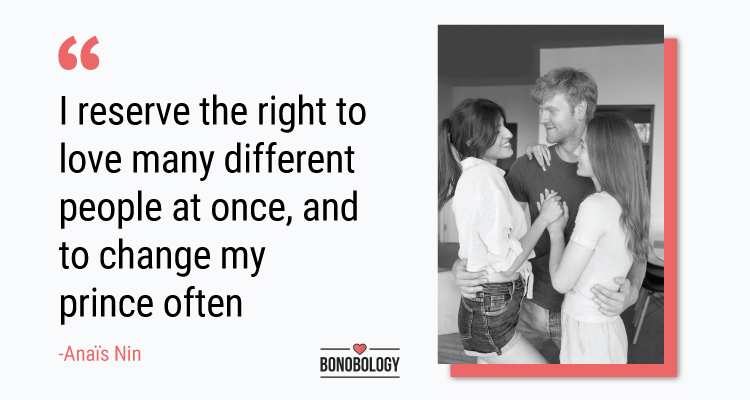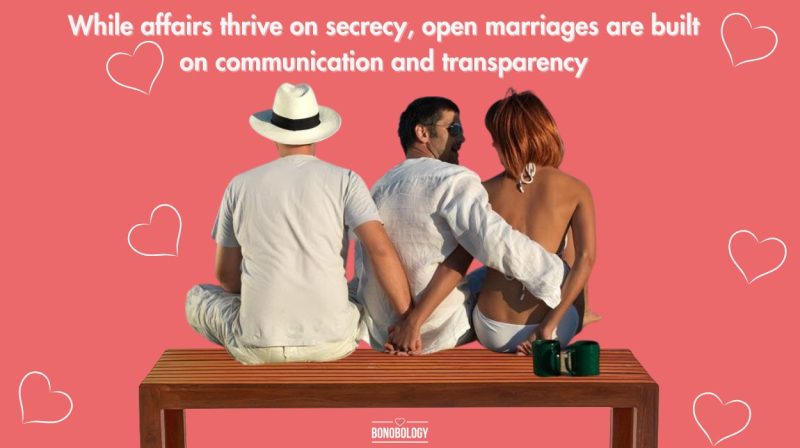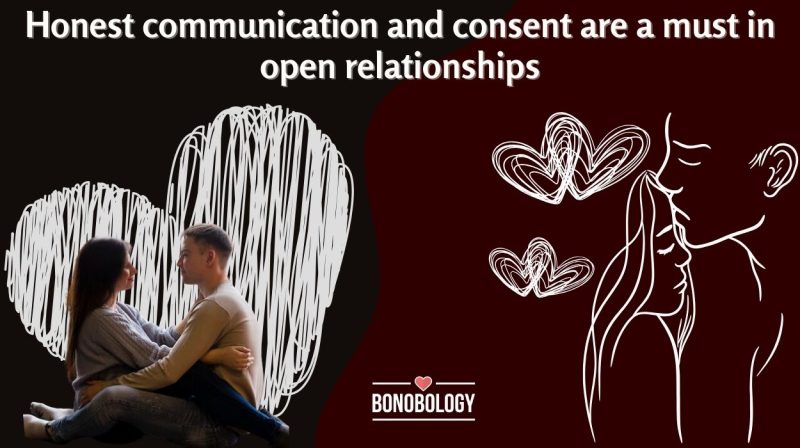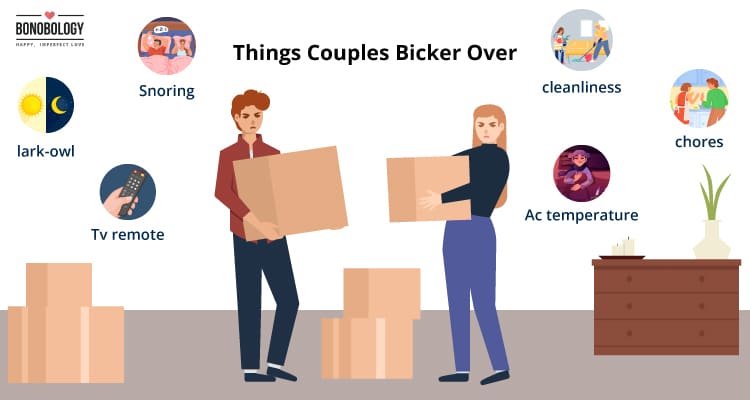Well, polyamory is just a complicated, half-Greek, half-Latin, term for an open relationship, right? Errr… you may be wrong on that one! Don’t worry though, ethical non-monogamy (ENM) or consensual non-monogamy (CNM) can be a tricky terrain, and polyamory vs open relationship confusion is quite common!
Since societies across the world today largely practice monogamy, we have accepted it as matter-of-fact. Be it a romantic relationship or a marriage, we just grow up imbibing the idea of a monogamous setup. And in the process, crush our capacity to love more than just “the one” by stigmatizing and criminalizing multi-love and calling it infidelity or adultery. But as society has progressed, people have come to embrace the desire to love or have physical or romantic intimacy with just “the one”. And frankly, we are all for it, if that’s what you want!
Regardless, it is tricky business and it’s important to understand the nuances of such relationships. With less conversation and lesser education around these concepts, there are a lot of mix-ups. But, today, we have on board counselor Niyatii N Shah, who is a sexuality educator and intimacy coach, to help resolve all our doubts with a few simple definitions of each of these concepts and much more!
What Is Polyamory?
Table of Contents
Do you often wonder, what is polyamory? Who are these mythical, elusive, awesome polyamorous people, and where do they come from? Niyatii answers in detail beginning with an important reminder, “It’s important to approach the topic of polyamory with an open mind and a willingness to learn.”
She goes on to explain, “Polyamory is an orientation, and people who identify as polyamorous may be of any gender, sexual orientation, age, or cultural background. Some may be interested in exploring multiple romantic relationships, while others may prioritize physical intimacy with multiple partners.
Polyamorous relationships are based on the principle of consensual non-monogamy, where all parties involved agree to engage in multiple romantic relationships or sexual relationships with each other’s knowledge and consent.”
So, what we have learned so far?
- In polyamory, partners seek and maintain more than one primary relationship where they are emotionally involved with each other
- The connection they seek is romantic and emotional and is usually meant for the long-term
- It may involve sexual intimacy but that is certainly not the sole aim of bonding with other people
There isn’t a rigid structure to a polyamorous relationship other than that there should be consent and that people are free to love more than one person. Poly equations can be of various kinds with any number of people. The status of the group can be dynamic or fixed. The key here is consent and equal status. Here are a few polyamory types and terms to get a hang of what we are about to discuss:
- Triad, Throuple, or Triangle: A group of 3 people
- Square or Quad: A group of 4 people
- Polycule: A network of interconnected relationships, usually bigger than 4 people because the geometrical shape-based terminology can get complicated
- Open polycule group: The group is open to adding more people or allowing new intimate relationships to form. If you find the confusing term “open polyamorous relationships” being thrown around, depending on the context, you can assume that it refers to an open polycule
- Closed polycule/Polyfi group: Each person in the group agrees not to look any further
- Solo Poly: A person who is okay with their partner exploring other relationships but would like to be monogamous toward this partner
- Hierarchical polyamorous group: Some people and bonds in the group are more important than others. This is often frowned upon in the polyamorous circle
- Non-hierarchical polyamorous group: All people in the group hold equal status and power to make decisions or negotiate the terms of the relationship
Related Reading: 5 Things To Consider Before Beginning A Polyamorous Relationship
What Is An Open Relationship?
“What we are more familiar with are traditional monogamous romantic connections or a monogamous marriage, which are socially closed relationships,” says Niyatii. “Two people promise to be partners to one another. Add to this setup more people, the partnership becomes ‘open’.” While this is not the official open relationship definition, it is a good way to understand the foundation of the term.
The term open relationship is thus used with two meanings. First, as a simpler term that includes any kind of ethical non-monogamy. In common parlance, people tend to call all ethically non-monogamous relationships as open relationships. Thus making polyamory also a type of open relationship.
On the other hand, what does it mean to be in an open relationship in the right use of the phrase? Let us take its characteristics:
- Open relationship is a term used to specifically point to a relationship between two committed partners, in which either both or one of them is seeking sexual connections with other people
- In an open relationship, the emotional connection is still with the primary partner, while outside relationships with the sexual partners are just for sexual satisfaction or variety
- The mediums for sexual sharing can be one-night stands, a bootie-call, a friends-with-benefits situation, finding a unicorn, a brief fling, swinging, or any other arrangement depending on what the couple agrees to
- Romantic intimacy is actively discouraged
- An open relationship can work as a great way to enhance sexual energy, sexual desires, and excitement in a relationship
If all this information so far has been overwhelming, fret not! We will be exploring each of these CNM bonding styles by putting them against each other. This is often the best way to understand something, allowing us to really look at the nooks and crannies.
If you are curious about what is the very foundation or what sustains an ethically non-monogamous relationship or are wondering how to start a poly relationship, read till the very end!
Related Reading: Does A Friends With Benefits Relationship Actually Work?
Polyamory Vs Open Relationship – 8 Key Differences
Since polyamory and open relationships involve multiple intimate connections, be it sexual, romantic, or both, these often get shoved into the same box of non-monogamy. But before we zoom into the key differences between the two, we asked Niyatii if she felt that consensual or ethical non-monogamy (CNM or ENM) was on the rise.
“Based on my thirteen years of experience as a couples counselor, I can say that CNM is definitely on the rise in recent years. Online dating platforms, social media, and the availability of information on ethically non-monogamous relationships have all contributed to increased visibility and acceptance. As a result, more people are exploring non-traditional forms of relationships,” she responded.
However, Niyati draws our attention to an important fact. “Polyamory is not a new concept and has been practiced by various cultures and societies throughout history. This rise in recent years may simply be a reflection of society’s evolving attitudes toward relationships and sexual orientation.”
Now that we know that we have forever been generous with our love, let us look at some of the ways how. Here are 8 key differences between polyamory vs open relationships.
1. The focus and the intent
“While the focus in an open relationship is on sexual non-monogamy, in polyamorous relationships, it is on romantic and emotional non-monogamy. This is a fairly critical distinction between the two,” says Niyatii. Partners in a polyamorous relationship often share feelings, life goals, and daily experiences with each other. Emotional connections and deep bonds are cultivated among multiple partners.
In contrast, we know what is an open relationship and what its focus is. At the center is the primary partner, with any external connections remaining primarily sexual and secondary in nature. Emotional involvement with outside partners is often limited or discouraged. The focus is on maintaining the primary bond while allowing for sexual freedom.
Now, one goal is not better than the other, just different. What you want from your relationship will decide what’s best for you. It is better to acquaint yourself with, say, the pros and cons of all kinds of open or ENM relationships and see if the lifestyle suits you.
2. Relationship structure
As we discussed earlier, we know that polyamorous relationships can be structured in different ways. There could be several polyamory types such as a closed triad with three people; or a dynamic quad with four people. There could be more people involved in a polycule with a plethora of possible combinations.
Open relationships, on the other hand, are typically based on a primary partnership that permits one or both partners to have casual sexual encounters outside the relationship through casual relationships. Since the outside relationships are highly dynamic and often inconsequential, there is no variation in the primary shape or structure of this relationship.
Related Reading: 12 Best Polyamorous Dating Sites For 2022
3. Communication and transparency
“To practice polyamory, one needs courage, honesty, and a high regard for transparency. A polyamorous relationship requires the same level of communication, trust, and respect as a monogamous relationship, if not more, due to the complexity of having multiple partners,” says Niyatii.
Communication is important in any relationship and more so in non-monogamous ones. In fact, both polyamory and open relationships require open communication and transparency. However, poly relationships often demand a higher level of communication due to the emotional investment and multiple relationships involved. It is also important that there is sound communication between all the partners in the relationship.
On the other hand, in an open relationship, effective communication must exist between the main two partners or “primary partners”. There effectively isn’t a need for communication with secondary sexual partners as those connections are often short-lived.

4. Relationship hierarchies
Talking about the “main partner” or “primary partner”, in open relationships, there is usually a clear hierarchy, with the primary relationship, also called a central relationship, taking precedence over any outside connections. This is a hierarchical relationship and is simple to comprehend. But, the case of relationship hierarchy in polyamory is much more complex.
While, polyamorous relationships may or may not have a hierarchy, depending on the individuals involved, some polyamorous individuals practice hierarchical polyamory, where primary, secondary, and tertiary relationships are established. Many others opt for non-hierarchical, or egalitarian polyamory, which prioritizes all relationships equally, where no single person has extra influence over the others.
Taking this further, some polyamorists practice “non-hierarchical relationship anarchy”, where they reject any form of hierarchy not only in their relationship structure but also in their social networks. Which means they reject them in their romantic, sexual, and platonic relationships. Partners are not more important than friends. And intimacy or romance is not just reserved for people they have sex with.
5. Boundaries and rules
Has this been overwhelming so far? If it has, you would understand this point better. Being in a polyamorous relationship means there are more complex polyamorous relationship rules and boundaries to ensure that all parties feel secure and respected. These agreements can include things like time management, emotional support, living arrangement and related divisions, and other relationship expectations.
Open relationships, meanwhile, typically have simpler rules and sexual boundaries. The focus is on regulating external sexual connections and degrees of sexual involvement, and on discouraging emotional involvement with other people. Here are two examples to drive home the point we are trying to make.
- Open relationship: A couple agrees to have sex with other people when they are traveling separately. They communicate and agree on the boundaries for the sexual encounter, which might include things like safe sex (condoms, dental dams, etc.), use of sex toys, communication about when the encounter happens, and other such practical matters. When they return home, they resume their relationship as usual. Or they talk about it, depending on their personal preference
- Polyamorous relationship: A person has two partners who they live with and see every day, and they have other partners who they see less frequently, but with whom they share deep connections. In this scenario, flexibility might come in the form of negotiating time and attention among all partners, such as by scheduling time with each partner or making sure that everyone’s needs are being met
6. Community involvement
Polyamorous individuals often participate in a larger community of like-minded people who share resources, advice, and support. “This community involvement can be an essential aspect of the polyamorous experience,” says Niyatii. To a historically monogamous person who now wishes to explore such relationship styles, community support and education can provide the right initiation.
In contrast, open relationships may not necessarily involve a community aspect, as the focus remains on the primary partnership and individual pursuits. Community involvement is often shunned as open relationships are largely kept private, or at most extended to a private closed circle, for example, a partner-swapping or a swingers’ club.
7. Social recognition and self-identity
It is clear from the last point that poly relationships involve a degree of social recognition, with some partners choosing to celebrate their commitments through ceremonies or other public declarations, such as a polyamory marriage. This happens primarily because many polyamorists openly self-identify as polyamorous, proudly embracing this identity, making polyamory a social movement!
Open relationships, however, are usually centered around the primary couple, with outside connections remaining more private. While it will be wrong to say that no open relationship enthusiasts are open about their sexual identity, it is frequently observed that practitioners of the open lifestyle discuss and practice it in a hush-hush tone. Think of the rumored “open marriage” in your social circle or the celebrity swinging club that is part of the gossip tabloid!
Related Reading: 11 Types Of Taboo Relationships You Should Know About
8. Fluidity and flexibility
Both polyamory and open relationships can be fluid and adaptable to the needs of the individuals involved. However, being in a polyamorous relationship means that one has to be more flexible, fluid, and accommodating. This is because there are typically more people involved and more potential for overlap and complexity in the relationship.
For example, you could be in love with three people. Each of these three people may have different desires, different sexual and romantic preferences, and different expectations from the other relationships. One of them may want to explore more relationships, while another may want to only love a single person while allowing others to love more people. This leads to everyone engaging in a more intentional negotiation around boundaries and expectations than open relationship partners will ever need to do.

Are There Any Similarities Between Polyamory And Open Relationships?
Understanding the differences between polyamory and open relationships can help individuals make more informed decisions about the type of relationship structure that suits them best. But along with the differences between polyamory vs open relationships, there are some similarities worth talking about that can make us understand CNM better. Let us look at what makes both these lifestyle choices awesome ways to accept one’s sexual and romantic desires while being respectful of everyone involved.
Speaking of the commonalities between these two lifestyles, Niyatii says:
- Both polyamorous people and open relationship partners actively commit to practicing consensual and ethical non-monogamy in the most respectful way
- Both kinds of relationships require open communication and negotiation for everyone to be on the same page
- Both prioritize the role of informed consent and respect for all partners’ boundaries and needs
- Both can be practiced by people of any gender, sexual orientation, or background
- Both require a high level of trust and honesty between all parties involved
- Both challenge traditional societal norms and expectations surrounding monogamy and relationships
- Both involve the possibility of jealousy and the need for emotional maturity and self-awareness to deal with jealousy and manage complex emotions that can arise
Related Reading: Top 9 Tips To Build Trust In Relationships
All of these points are pertinent to the discussion, but we would like to single out the very last of the points above and talk about the concept of “compersion”.
- Compersion is best understood as being the opposite of jealousy and is the foundation of a CNM lifestyle, especially a polyamorous one. Feeling joy in your partner’s happiness, or “compersion”, is what drives these relationships. As per a study, “feelings of self-worth, feeling secure, having one’s needs met in the relationship with the partner, and good communication with one’s partner” were important factors that facilitate compersion in a relationship
Key Pointers
- Both polyamory and open relationships are forms of ethical non-monogamy or consensual non-monogamy where romantic partners are allowed to love more than one person. What entails “love” differs between the two
- The open relationship definition limits to the needs of two primary partners in a relationship to have more sexual freedom outside of this primary relationship
- Polyamory meaning, on the other hand, extends far beyond. Several primary relationships (three or more) are fostered in a polycule, all with equal statuses, and all centered around emotional intimacy and romance. Sexual involvement differs
- Polyamorous relationships tend to be a much more complex form of ethical non-monogamy in comparison to an open relationship
- Compersion, or the feeling of finding joy in your partner’s happiness, is often considered the foundation for making these relationships work
So, whether you are interested in exploring a CNM lifestyle, or are curious, or if you landed on this page by (a beautiful) accident, this is a great opportunity to assess your current relationship and your capacity for love. Is it plagued by jealousy, or does it allow feelings of compersion — being happy for your partner’s happiness — in all aspects of life, including but not limited to love, romance, and sex?
Bonobology is a safe, informative space to explore these questions. You could look through relationship quizzes and explore relationship advice to help foster a healthy relationship with your partner marked by love, trust, communication, respect, excitement, and happiness. Or if you are looking to learn how to start a poly relationship, what better place to start the journey than getting in touch with one of our empaneled counselors, who can empower you with the right tools to start this journey? Look no further! We are here for you.
Platonic Marriage: Meaning, Benefits, And Tips To Make It Work
Online Affairs Reshaping The Idea of Fidelity In Modern Marriage
Your contribution does not constitute a charitable donation. It will allow Bonobology to continue bringing you new and up-to-date information in our pursuit of helping anyone in the world to learn how to do anything.






















Featured
My Wife Wants Open Marriage: 17 Tips To Navigate
Open Relationship Dating: What It Is & Why It Works
13 Glaring Red Flags Before Moving In Together You Should Never Ignore
Polyamorous Vs Polygamy – Meaning, Differences, And Tips
How To Make A Polyamorous Marriage Work? 6 Expert Tips
Are You Moving In Together? Checklist From An Expert
21 Expert Tips For Couples Moving In Together
Non-Monogamous Relationship: Meaning, Types, Benefits
Decorating Tips For Couples Moving In Together
How Soon Is Too Soon To Move In Together?
Cohabitation – Everything You Need To Know About It
Does A Friends With Benefits Relationship Actually Work?
Tips To Ease Moving In With Your Boyfriend
10 Open Relationship Rules That Have To Be Followed To Make It Work
Does Living Together Before Marriage Mean You Are Ready For The Wedding?
Marriage VS Live-In Relationship: Everything You Wanted To Know
What Are The Disadvantages Of Live-In Relationships?
5 Things To Consider Before Beginning A Polyamorous Relationship
7 Creative Ways To Ask Your Girlfriend To Move In With You
My friend invited me to his house and I fell in love with his wife